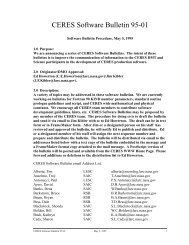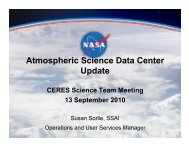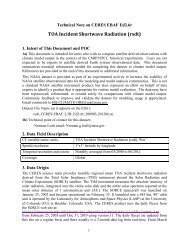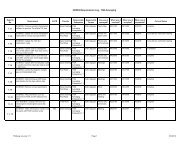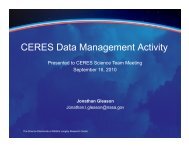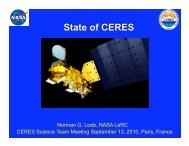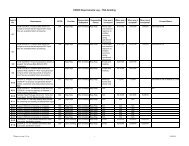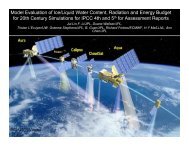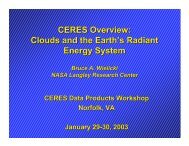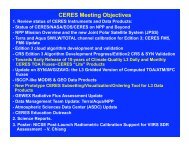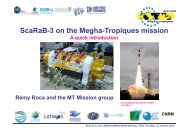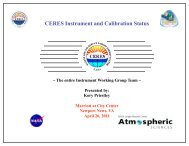GERB Update - ceres
GERB Update - ceres
GERB Update - ceres
Create successful ePaper yourself
Turn your PDF publications into a flip-book with our unique Google optimized e-Paper software.
Instrument status•<strong>GERB</strong> 2 (Meteosat-8) and <strong>GERB</strong> 1 (Meteosat-9) are currentlyin orbit– Edition data are currently available from <strong>GERB</strong> 2 for the period March 04to May 07, <strong>GERB</strong> 1 became the operational instrument after May lastyear, data still undergoing validation•<strong>GERB</strong> 3 is at Imperial undergoing re-calibration before satelliteintegration•<strong>GERB</strong> 4 is expected for calibration at Imperial later this year,unit level measurements of the mirrors and detector arecurrently on-going
Instrument status: in orbit G1 & G2•<strong>GERB</strong> 2 (Meteosat-8) and <strong>GERB</strong> 1 (Meteosat-9) are currentlyin orbit– <strong>GERB</strong> 1 (Met-9) is now the operational instrument, (since May 07), although thedata are yet to complete validation so are not released as Edition products yet.– Mirror behaviour on <strong>GERB</strong> 1 has been poorer than for <strong>GERB</strong> 2 and thus theinstrument has only been operated for very limited periods during the ‘eclipse’seasons (two months around each equinox), due to concern about detectordamage from mis-pointing events at these times.– <strong>GERB</strong> 2 is in ‘SAFE’ non-data collecting mode, with occasional activation forbearing movement and calibration checks.– Funding to carry out the studies to cross calibrate <strong>GERB</strong> 2 and <strong>GERB</strong> 1 has nowbeen secured and work on this is due to start this month (May 08)– <strong>GERB</strong> 2 edition 1 ARG data is available for the time period March 04 to May 07.Validation of the BARG in anticipation of release is mostly completed, and thesedata should be released later this year.
<strong>GERB</strong>-1 Operations summary1 2 3 4 5 6 7 8 9 10 11 12 13 14 15 16 17 18 19 20 21 22 23 24 25 26 27 28 29 30 31MayJunJul 1 2 3AugSepOctNov 4Dec 5 6Jan '08FebMarAprNORMAL Reduced Sun Avoidance mode 3 TL Test [1-3]NORMAL + Cal Activity Outages - Packet Corruption 4 AHKL temperature updateSUNBLOCK 1 Load Patch 15 5 Begin FIFO mode testingNORMAL - latch up 2 Patch Conflict Test 6 End FIFO test
Instrument status: G3 in calibration•<strong>GERB</strong> 3 is at Imperial undergoing re-calibration (due to lengthof time since first calibration) before satellite integration– Additions and improvements to the original calibration procedure include:• A wider range of temperature for the warm black body calibration source (nowminus 250 to + 345K, previous minimum temperature was 280K), greater pixelcoverage•Improved pixel coverage of the spectral response spot checks, achieved bymodifying the instrument mounting within the calibration chamber, andadditional wavelengths by using more filters and a higher output source. Anew window for the IR to allow IR spot checks to be made in vacuum•A shortwave calibration source with much more energy at shorter wavelengths
<strong>Update</strong>d VISCS spectra•Changes to the shortwave calibration source for <strong>GERB</strong> 3 (and 4) calibration
Latest validation results (<strong>GERB</strong> 2)• Following on from the <strong>GERB</strong> ARG-CERES SSF Ed2 rev1 comparisons, the <strong>GERB</strong> BARG and HR data formatshave been compared to CERES– Overall (average) results are the same as for the ARG (<strong>GERB</strong>around 5% higher in SW and 1% lower in LW than CERES), butthe scene dependency present in the ARG is not exhibited forthe BARG comparisons.– It is thought that the apparent scene dependency in the ARGcomparisons comes not from differences between CERES and<strong>GERB</strong> spectral response but is present in ARG because:• (a) the uncorrected PSF - the comparison method only matches CERESpoints to the centre of the ARG PSF and applies no weighting, thus thewings of the PSF are ingnored;• (b) the rectification of the data to the ARG grid is by linear interpolation;• (c) geolocation errors result in occasional contamination leading to bias inthe extreme scenes,– the BARG processing attempts to correct each of the issues thusthe scene dependence is eliminated
Latest validation results: SW radiance
Latest validation results: SW flux
Latest validation results: LW radiance
Latest validation results: LW flux
Future plans• BARG release ED1 (March 04-May 07)– Complete validation of the BARG processing: PSFremoval and averaging procedures– Finalise strategies for providing estimates of missingdata: terminator, sunglint, LW night for Sun avoidanceperiod (20:30 – 01.30)• <strong>GERB</strong> 1 validation– Intercomparison between <strong>GERB</strong> 1 and <strong>GERB</strong> 2 (workbegun)– Comparison of <strong>GERB</strong> 1 and CERES– Analysis of the flight spare detector calibration results
Summary• <strong>GERB</strong> 2 (MET-8) edition 1 data available from March 04 to May 07• <strong>GERB</strong> 1 (MET-9) is now the operational instrument since May 07,data undergoing validation• <strong>GERB</strong> 3 undergoing system level re-calibration at Imperial• <strong>GERB</strong> 4 at unit level calibration prior to full assembly, will havesystem calibration later this year• New validation results for <strong>GERB</strong> BARG (PSF removed) data, incontrast to ARG products comparison with CERES SSF Ed 2 rev 1shows no scene dependency for BARG. Overall difference (5% SW,1% LW radiance) same as for ARG. Results submitted forpublication.• Estimates for missing data are planned for inclusion in a data fillfield in the BARG edition products, expected release this year
Enhanced Spectral response spot checksAdditional narrow bandpass filters havebeen acquired to enhance knowledge of theIOU spectral response (10 m and 20 mfilters are also used but not shown on thisplot)The additional filters improve the resolutionand number of samples of the spectralresponse spot check measurementsA window change (to ZnSe) is also made inthis calibration to allow infraredmeasurements to take place under vacuumA ZnSe vacuum window (600 nm – 20 m) for use with thelongwave filters beyond 2.5 m. Allows for operation ofthe instrument under vacuum
Instrument status: G4 ‘in build’•<strong>GERB</strong> 4 is currently under unit level calibration, withmeasurements on-going on the detector (now the flight sparefrom the <strong>GERB</strong>1-2 batch) and the sample mirrors.– IEU current circuit modification completed and inspected, undergoingfunctional tests– IOU in storage awaiting completion of detector calibration to allow FPAintegration– Detector on the FPA being calibrated at LU expected completion in July.Improved calibration procedures include characterisation of within beamvariation in intensity with wavelength and redefinition of measurementwavelengths– Re-specification of wavelengths for mirror measurements, so as to bettercharacterise the shortwave drop-off region (
<strong>GERB</strong> BARG release: data additions• Recovered ‘sun glint’ SW fluxes over land• A ‘fill’ field to contain estimates for the most significantmissing data:– SW flux for ocean glint region• Estimate by holding scene constant through glint period when scene ID isnot available– terminator region (SZA 80-90°) and twilight (SZA 90-105°) SWfluxes• Terminator fluxes estimated using an average ADM and measuredradiances• CERES twilight values adjusted for consistency with <strong>GERB</strong> flux(<strong>GERB</strong>/CERES radiance ratio)– LW flux for 5 hour outage (20.30-01.30) during sun avoidanceperiod• Estimated from <strong>GERB</strong>-like data with the application of a grid point specificcorrection based on the previous 30 days (all available hours) of <strong>GERB</strong> and<strong>GERB</strong> observations



